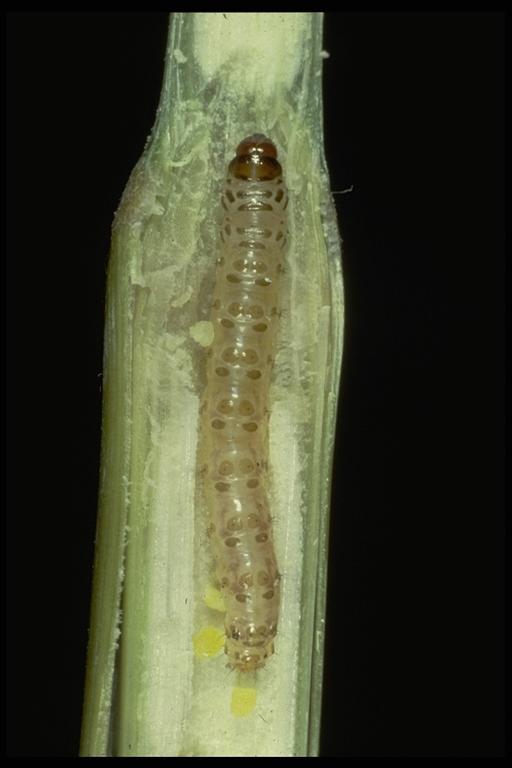 Common Name: Sugarcane borer
Common Name: Sugarcane borer
Scientific Name: Diatraea sacchari (Zehntner)
Order: Lepidoptera
Description: Full grown caterpillars are about 1 inch long, white to yellow with rich brown head capsules and first thoracic segment. Each body segment is marked with round brown to black spots. Adults are small brown moths with darker brown bands on each forewing.
A number of other pyralid stalk borer species are agricultural pests in Texas. The European corn borer, Ostrinia nubilalis (Hübner), southern cornstalk borer, Diatraea crambidoides (Grote) and southwestern corn borer, Diatraea grandiosella Dyar are primarily pests of corn in the Texas Panhandle. Caterpillars of European corn borers are brownish to pinkish with small dark spots on each body segment, whereas those of the southern cornstalk and southwestern corn borers are yellowish-white with round brown spots on each body segment similar to the sugarcane borer. In the southern part of the state, the Mexican rice borer, Eoreuma loftini (Dyar) has a similar biology and host range to the sugarcane borer. Caterpillars lack dark spots but have two purple-red stripes similar to dashes on each body segment that do not connect to the stripes on adjacent segments. Along the Texas coast, rice stalk borer, Chilo plejadellus Zincken, caterpillars also lack dark spots, but have a pair continuous light brown to purplish stripes all along the sides of their bodies.
Life Cycle: Full grown larvae overwinter in cells in crop stubble and pupate in the spring. Mated female moths lay elliptical to oval eggs in clusters that appear like fish scales on the midrib of the upper surface of leaves. Tiny caterpillars hatch in 3 to 7 days and develop through several stages (instars) over about 25 days before pupating. Adults emerge from pupae in about 10 days. Up to five generations can occur annually.
Habitat and Food Source(s): Caterpillars have chewing mouthparts. Adults have siphoning mouths. Host plants include sugarcane, corn, sorghum, rice, pampas grass and other cultivated and wild tall grasses. Feeding by young larvae near the soil line on small plants causes the growing point to die, a symptom called “deadheart”, which can reduce plant stands. On older plants, young larvae first tunnel into the leaf sheath and axil. Older larvae tunnel into the stalk (pith). On sorghum and some other plants, damaged areas develop a purple to reddish discoloration. Heavily injured plants can be stunted, have reduced seed production, break over (lodge) and may die. In rice, seed head development is interrupted by larval tunneling causing a symptom called, “white heads.”
Adults can be reared or collected at lights. Sex attractants (pheromones) are available to attract the males of several pyralid species.
Pest Status: Caterpillars (larvae) feed in stalks of crops, ornamental plants and weeds, occasionally reducing yield in heavily infested plantings; occur in the eastern half of the state from south Texas through the coastal bend; medically harmless.
For additional information, contact your local Texas A&M AgriLife Extension Service agent or search for other state Extension offices.
Literature: Browning et al. 1989. Little 1963. Teetes et al. 1983.